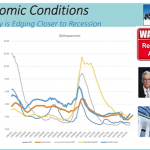New Jersey Future Blog
New Jersey Losing Population for the First Time in Four Decades
January 16th, 2020 by Tim Evans
 A long-term decline in the national birth rate and a recent drop-off in immigration have joined forces with ongoing out-migration to other states to produce New Jersey’s first population loss since the late 1970s.
A long-term decline in the national birth rate and a recent drop-off in immigration have joined forces with ongoing out-migration to other states to produce New Jersey’s first population loss since the late 1970s.
The Census Bureau recently released its annual national and state population estimates for 2019, and there is some notable news for New Jersey: New Jersey has now joined the ranks of states that are losing population. Granted, it is a very small loss, with the state’s population declining by an estimated 3,835 residents, or 0.04 percent, from 2018 to 2019. And New Jersey has plenty of company: Nine other states have also lost population since 2018 – Alaska, Connecticut, Hawaii, Illinois, Louisiana, Mississippi, New York, Vermont, and West Virginia. All but Vermont and Alaska lost more residents than New Jersey did, and New Jersey’s was the smallest loss in percentage terms.
Still, this is the first time since the dark days of the 1970s, when large urban areas throughout the Northeast and Midwest were hemorrhaging population, that New Jersey has experienced a year-over-year population loss. The state lost 1,959 people from 1972 to 1973 and another 674 from 1973 to 1974; lost 2,575 from 1976 to 1977; and lost 1,691 between 1979 and 1980. Since 1980, though, New Jersey has managed to stay above water, even when other Northern states (and a few Southern ones) experienced periodic year-to-year losses.
Why has New Jersey now lapsed into actual population decline for the first time in 40 years? One contributing factor is that New Jersey loses more domestic migrants to other states than it attracts from other states. New Jersey Future has pointed to New Jersey’s net domestic outflow before, particularly among Millennials. Between 2018 and 2019, New Jersey lost a net of just under 49,000 people due to domestic migration (that is, about 49,000 more people left New Jersey to move to other states than people who moved to New Jersey from other states). But this net out-migration is not new. New Jersey has lost at least 45,000 net domestic migrants every year of the 2010s, with individual annual losses reaching as high as almost 67,000 between 2015 and 2016. The 2018-19 loss is actually among the smaller ones this decade. Net domestic out-migration, while an ongoing concern, has not gotten any worse in the last year, so we must look to the other components of population change to explain the overall loss.
In past years, immigrants to New Jersey from other countries have roughly counterbalanced out-migrants to other states, with the result that immigration plus natural increase (births minus deaths) has provided New Jersey with a small net positive growth rate. But not this year. The big story from this year’s state population estimates is the dramatic decline in net international migration nationwide. At the national level, according to the Census Bureau’s press release, immigration is down from 1,047,000 in 2016 to only 595,000 in 2019, a drop of 43 percent. New Jersey, traditionally one of the country’s top immigrant magnets, has experienced an even bigger dropoff, from a net 50,087 international immigrants between 2015 and 2016 down to only 21,284 between 2018 and 2019 — a decline of more than half. Such a reduced rate of immigration, if it persists, would no longer be enough to offset New Jersey’s steady loss of domestic migrants to other states, meaning that New Jersey – and New York, and Illinois, and other states that have recently been relying on immigrants to compensate for domestic out-migration, possibly soon even including California – could be on a path toward sustained population loss.
Another factor at work is more of a long-term phenomenon – a decline in “natural increase,” which is the difference between births and deaths. (This is what population change would look like if no one ever moved across state borders or between the United States and other countries.) Birth rates have been declining throughout the industrialized world, and the United States has been no exception. Meanwhile, we should expect the number of deaths to increase in the next two decades as the Baby Boomers – the largest generation in American history until their children, the Millennials, recently overtook them – begin reckoning with mortality in large numbers. (The oldest Boomers turn 74 this year.) As another sign of this graying of the population, the Census Bureau estimates that by 2030, people over the age of 65 will outnumber those under 18 for the first time in US history.
The Census Bureau’s press release about 2019 state populations points to the fact that natural increase nationwide dropped below 1 million in 2019 for the first time in decades, whereas it had held steadily above 1.5 million annually throughout the 2000s and was still above 1.3 million as recently as 2015. During the 2000s, New Jersey’s natural increase averaged around 41,000 per year, ranging from a low of 38,795 between 2008 and 2009 to a high of 46,272 between 2007 and 2008. But natural increase declined steadily in the 2010s, from an increase of 35,620 between 2010 and 2011 all the way down to 23,778 between 2018 and 2019.
West Virginia and Maine have been experiencing natural decreases (where the number of deaths exceeds the number of births) for the whole second half of this decade, and this year they are joined by Vermont and New Hampshire. Such decreases will probably continue to show up in more and more states in the coming decade, especially if Millennials continue to not have children at the same rate as previous generations. In West Virginia and Vermont, neither of which attract many immigrants from other countries and both of which typically lose domestic migrants to other states, a declining rate of natural increase has already translated into overall population loss; both states have experienced year-to-year population losses more than once in the 2010s. Maine and New Hampshire have continued to grow mainly by attracting domestic migrants from Massachusetts; without these new arrivals from Metro Boston, they would be in much the same position as Vermont.
If a dramatically reduced immigration rate turns out to be the new normal instead of a temporary disruption, and as the more long-wave phenomenon of declining rates of natural increase begins to make itself felt, state population growth in the United States may come to resemble a zero-sum game, where any state’s growth must necessarily result in some other state’s loss. If such a scenario comes to pass, New Jersey, with its established pattern of out-migration to Pennsylvania and to Southeastern states like Florida, Virginia, and North Carolina, may evolve into one of the nation’s biggest population “donor states.” New Jersey has control over neither national immigration policy nor a declining birth rate that is common to most of the industrialized world. Nor can it change the weather, which has been luring retirees to Florida for many decades. But if the state cannot find a way to make itself more affordable to younger generations and allow people to stay here or move here even when they want to, this year’s small loss could be a harbinger of larger problems down the road.
Related Posts
Tags: birth rates, immigration, internal migration, Population, state population, trends
















